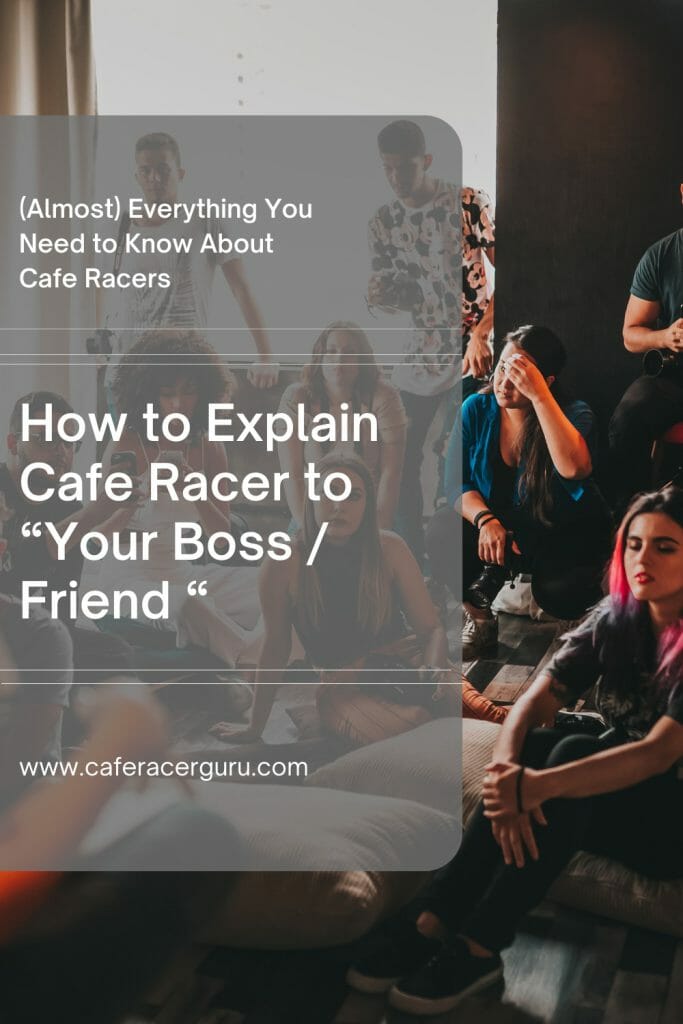If you’ve been having a tough time explaining café racers to your friends, your family, your coworkers, neighbors, or even your boss just know that you aren’t alone – not by a long shot!
Everybody knows a motorcycle when they see one, and most people can tell the difference between a cruiser like a Harley-Davidson and a sport bike like a Suzuki GSXR, but that’s pretty much where most “normal” folks draw the line.
Serious motorcycle enthusiasts, though, know that there’s a world of other motorcycle types out there – and café racers are some of the most popular options for sure.
To better help you explain to the folks in your life that might not fully get café racers, we put together this quick guide.
Ready to jump right in?

Quick History of Cafe Racer
To put it simply, café racers are super lightweight, super stripped down, and often souped up racing motorcycles that have a very vintage and retro sort of look to them.
This isn’t on accident.
The very first café racers came to be in England during the early 1960s, especially around coffee shops in London.
Motorcycles were stripped down, chopped up, and peeled apart to their bare essentials and used for quick rides between cafés and around town.
Motorcycles were the preferred form of transportation in post-World War II Britain for a long time, and these lightweight and “bare-bones” motorcycles were beloved by the population.
By the mid-to-late 1960s, though, the English economy bounce back in a big way and motorcycles started to fade into the background as people bought bigger and bulkier cars.
In response a counterculture popped up amongst serious motorcycle enthusiasts, looking to build bikes that were fast, that more reliable, and that (maybe above all else) looked damn good all at the same time.
Café racers were born.
It didn’t take long for this style of bike to start to expand all over the world, either.
By the early 1970s people in the United States and in Australia were getting in on the action, and it didn’t take long for these kinds of motorcycles to start popping up throughout Europe and the rest of North America.
The earliest café racers were made from English motorcycles like Nortons but today it’s a lot more common to see Honda and BMW bikes get the café racer treatment more than may be anything else out there.
You Know it WHen You See it
The tricky thing in describing café racers is that no one racer looks exactly like any other – and that’s on purpose.
Every café racer has its own unique personality, a couple of different style tweaks and twists, and different influences from the folks that put them together (or strip them down) that really gives them a unique fingerprint.
At the same time, all racers definitely follow the same kind of “theme” that you’ll notice the second that you lay eyes on one.
We are talking, of course, about motorcycles that are generally stripped down to their bare essentials. Peel back every bit of plastic, get down to bare metal, and then breathe vintage life back into these bikes.
Clean lines and flat, elongated seats, super slim gas tanks, and short handlebars with oversized lights upfront all help to give café racers a similar look across the board.
Sure, some people build bikes that are a little more “modern” looking than your typical café racer. But almost all bikes have the same kind of spirit, the same kind of soul, and the same kind of energy that British café racers back in the 1960s would have had.
Expect to see a lot of metal, a lot of engineering, and a lot of leather work on these kinds of bikes.
Take Them For a Ride
If you really want to get people familiar with café racers, though, it’s not a bad idea to offer to take them for a ride on the back.
Not everybody is going to feel super comfortable zipping around with you on your café racer, but there isn’t any better way to get new people excited about everything that these kinds of bikes bring to the table than a real ride.
Feeling the road beneath you, the wind in your hair, and the way the bike responds to every twist and turn is something that is (literally) impossible to put into words.
Something happens when you are cruising around on a windy back road or zipping through a busy city on a café racer that you feel deep down in your bones – even if you aren’t the one driving it!
Combine that with the sound these bikes make (totally different and distinct from anything that a super sport or Harley-Davidson sounds like) and vintage feel café racers have and it’s not hard to get people hooked on these kinds of bikes, either.
Obviously, it’s important that you are a great ambassador for these kinds of motorcycles as well.
If someone does decide to climb on the back of your bike you need to be sure that their experience isn’t just exciting and a lot of fun but that it’s also 100% safe as well.
Don’t decide to open things up out of nowhere. Don’t decide to zoom through different lanes of traffic just because café racers are quick and whole. Don’t decide to take the kinds of risks you might have felt comfortable taking it was just you on the back of the bike.
Slow things down, let your passenger soak in the history and excitement every café racer pushes out, and allow the bike to do the bulk of the heavy lifting for you when it comes to the overall experience.
At the end of the day, there’s no better way to teach people about café racers or to open their eyes about these kinds of bikes than by getting them on one so they can see what all the fuss is about for themselves.